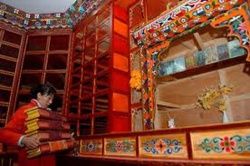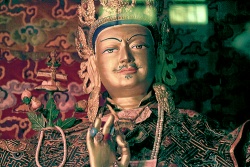Dharma-King Cave and Cliffside Carvings
Of the sophisticated architecture of the Potala Palace, the Dharma-King Cave and Phagpalakang Hall are the only two parts dating from the Tubo Kingdom 1,400 years ago.
The cave was carved out of a rock at the top of the Potala Palace. During the Tubo period, King Songtsan Gampo used to meditate there. In the center of the cave is a stove.
A stone pot and mortar sit on top of the stove. Inside the cave are several statues, including one of Songtsan Gampo. The statues are very different in sculpting technique and style from statues that depict the king and his wives and ministers in the late period of the Tubo kingdom.
The statues are believed to date from the Tubo period.
The cave is 3.7 meters hgh and has two pillars, which remain in good shape. The pillars are carved with animal faces and Mani pearls in the style of the Tubo period.
When the Potala Palace was repaired in the 1990s, the wooden poles that had been erected to support the ceiling of the cave were removed, making the 27-sq. -m cave appear more spacious.
Two white pagodas are located one on each side of the cave.
The Phagpalakang Hall, meaning the Supreme Buddhist Hall, is above the cave. It is the oldest and most sacred hall in the Potala Palace. Phagpa Lhobsangxarag, or the Tibetan version of the Goddess of Marcy, is worshipped in the hall.
It is a wooden statue, said to have been worshipped personally by King Songtsan Gampo.
It is the most important icon in the Potala Palace. The statues was once lost somewhere in Qinghai. In 1645, a Yuan Dynasty empress had it sent back to Lhasa. in 1996, the statue was stolen, but it was soon recovered.
There is a legend associated with the statue. When Songtsan Gampo was building the Potala Palace, he received a message from God that a Buddhist statue should be made to benefit all the living beings. Bhiksu, a reincarnation of the statue, went to ancient India and Nepal.
In a forest, four Buddhist statues met. One of them, Lhobsangxarag, said he would go to the snowland of Tibet to be with king Songtsan Gampo.
The local monks and Tibetans respect the statue as a guardian who possesses boundless supernatural power and a protector of the peace and happiness of the people of Tibet.
They worship it as the soul of the Potala Palace.
In the niches on the four walls of the Phagpalakang Hall are statues of the fifth, seventh, eighth and ninth Dalai lamas and Great Teacher Tsongkhapa, and stones with the footprints of the Lotus-Born Great Monk, Tsongkhapa and the 12th Dalai Lama.
The Potala Palace is a magnificent and awesome building constructed along the contour of Mount Potala. Cliff-side carvings comprise part of the heritage of the palace.
Most of the carvings were done on the isolated cliffs on the first, second and fourth layers of the palace.
The carvings on the cliff-side to the east of the palace on the first terrace record the episode from the period of Emperor Kangxi of the Qing Dynasty when he dispatched Qing troops to Tibet in the 59th year of his rule.
Another carving on the same layer records the joint efforts of the Tibetans and the Han Chinese in fighting against foreign invaders and safeguarding the frontiers.
On the second terrace there is a cliff-side carving made in the sixth year of the reign of Emperor Yongzheng. It is still in good shape and the carved words are easy to recognize.
This carving records the turmoil in Tibet in the fifth year of Emperor Yongzheng's reign and the entry of Qing troops in the following year.
Four meters above the ground on the second terrace is a carving from the seventh year of Emperor Yongzheng's reign. Overlapping the signature are two large seals in the lishu, or official script.
The text is composed of a verse of four four-word lines, which read to the effect:
The South Mountain stands as the shield belt; the waving trees serve as the flags. Might and power are demonstrated; and the barbarians are deterred.
Ten meters above the ground on the fourth terrace is a carving recording the central route of the Qing expeditions against the Jungar rebels. Some other inscription carvings on the same terrace cannot be seen clearly because of overlapping carvings of Buddhist images done in later times.

